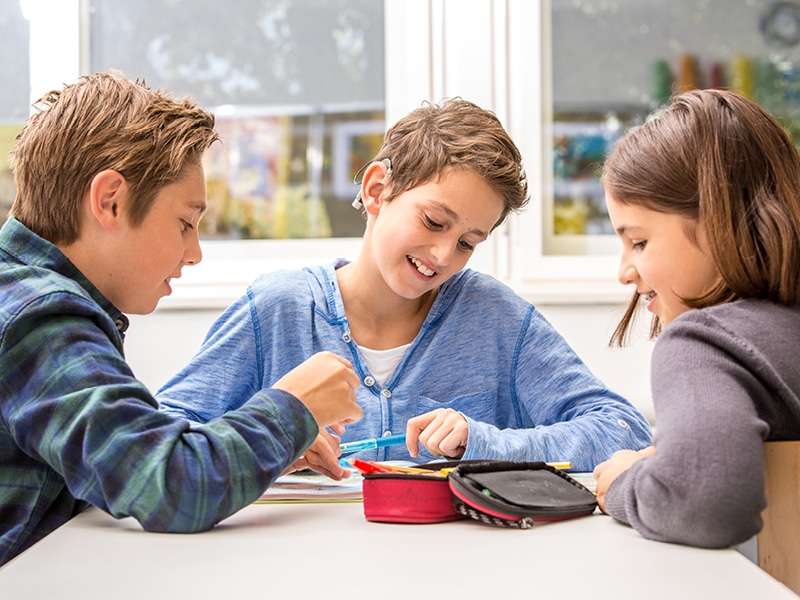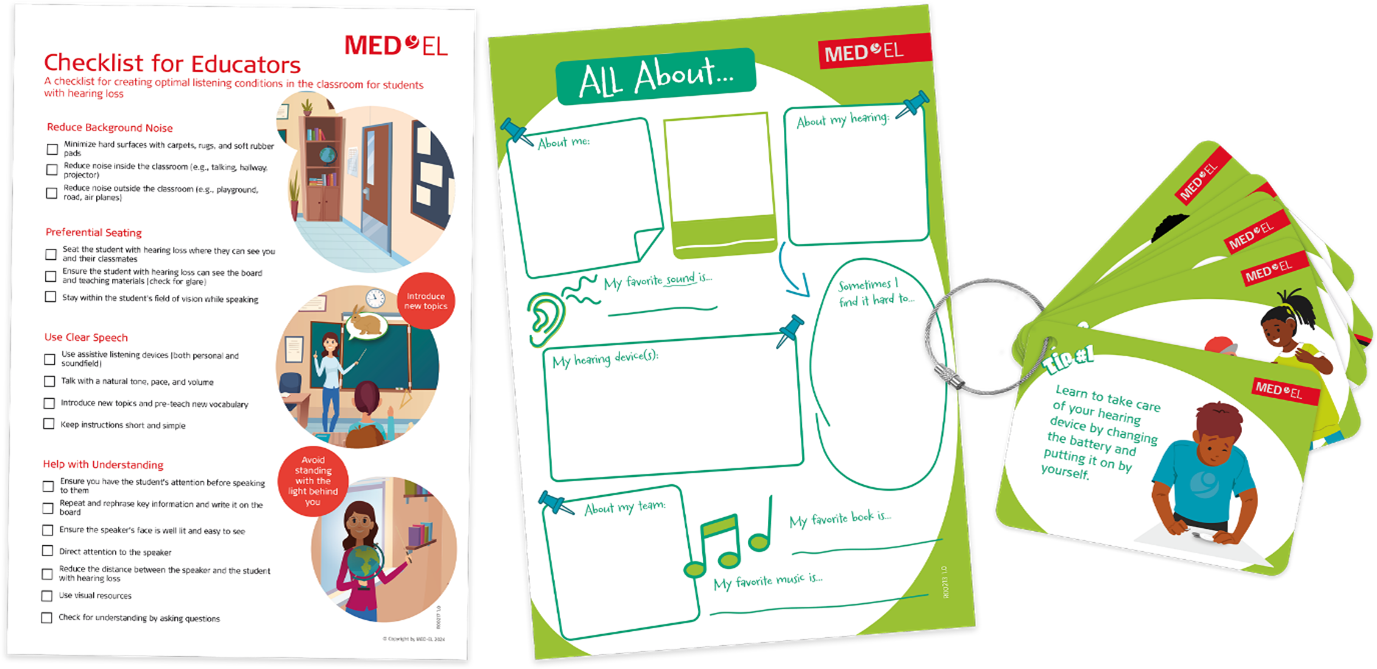MED-EL
Published Jul 11, 2023 | Feb 13, 2025
What Teachers of Children With Cochlear Implants Need to Know
From checking that students' devices are working properly to creating an environment that makes hearing easier, teachers of children with cochlear implants, hearing aids, and other hearing devices can make many small adjustments to facilitate learning.

Many children with hearing loss attend mainstream schools, and they can have difficulties participating in classroom activities. For example, it may be hard for them to follow instructions and join in group discussions.
Classrooms and schools are noisy places and interaction in noise requires finely tuned listening skills, the social use of language, and well-developed pragmatic skills.Paatsch, L., & Toe, D. (2020). The impact of pragmatic delays for deaf and hard of hearing students in mainstream classrooms. Pediatrics (Evanston), 146(Suppl 3), S292–S297. https://doi.org/10.1542/peds.2020-0242I[1] For some students who are deaf or have hearing loss, these challenges make getting along with their peers inside and outside the classroom difficult—even with age-appropriate language skills on formal measures of spoken language.
Mainstream schools are environments in which classroom dialogue is mostly in the form of verbal instruction. It includes dynamic, fast-paced conversation with some visual support such as smartboards, worksheets, and books. Oftentimes several people are speaking at the same time or the speaker is at quite a distance from the students, such as in whole-school assemblies or via loud speakers.
The Path to Academic Success for Students with Hearing Devices
Teacher-student and peer-peer interactions are required to maintain conversations and understand when to ask for clarification. The ability to understand and follow classroom instructions plays a key role in the academic success of students with hearing devices.
It is essential for teachers of children with hearing devices to know about and apply strategies and techniques that support educational equity for these students in their mainstream settings. With this differentiation in providing optimal access to classroom instructions, teachers can support these students in reaching their maximum learning potential.
Many mainstream classroom teachers have not had any training to prepare them effectively for teaching students with disabilities. Other teachers may not have had a student who is deaf or with hearing loss in their classroom for years.
MED-EL has developed free resources and blogs articles to assist teachers in addressing the needs of children who are deaf or have hearing loss and use hearing devices, such as hearing aids and cochlear implants.
Challenging Behavior May Indicate Hearing Device Problems
If a student’s behavior is challenging, it could be a sign that their hearing device has a flat battery or a technical issue. According to a 2021 study, the most common reasons students find it difficult to participate in classroom activities with hearing technology and assistive listening devices are as follows:
- The devices are not functioning, mainly due to flat batteries.
- Assistive listening devices are not used by the teacher and other students.
- The assistive listening device signal is not clear.Todorov, M., Galvin, K., Punch, R., Klieve, S., & Rickards, F. (2021). Barriers and facilitators to engaging in mainstream primary school classrooms: Voices of students who are deaf or hard-of-hearing. Deafness & Education International, 24(1), 2–23. https://doi.org/10.1080/14643154.2021.1992829[2]
Hearing in open-plan classrooms and large spaces such as gymnasiums and sports fields is also difficult due to distance and high background noise levels.
Studies have also shown that students with hearing loss are more likely to exhibit challenging behavior. Frustration from reduced access to classroom dialogue may be the root cause. To address this, check out our blog article that provides advice from experts on dealing with behavioral issues in the classroom.
Additionally, some students may not be confident to speak up or show obvious signs when their hearing device is not functioning optimally. The strategies mentioned below can help.
Students With Hearing Devices Can Be Taught to Advocate for Themselves

Classroom teachers can benefit from a better understanding of the child’s hearing loss. Reciprocally, students can take some responsibility for helping the teacher understand their needs throughout the day.
While each student’s needs are unique, there are strategies which broadly apply to most students who are deaf or have hearing loss in mainstream settings. Some students may need to be specifically taught about self-advocacy and provided with opportunities to develop their confidence.
To help teach students to become independent in managing their hearing devices and develop the skills to communicate their needs to others confidently, you can use MED-EL’s self-advocacy cards, which are free and available to download at the end of this article.
Teachers Can Get More Familiar With Students & Their Hearing Devices
Teachers can learn essential information about their students’ hearing devices and understand what hearing loss implies. Family members, the students themselves, audiologists, teachers of the deaf, and online resources can assist teachers in this process.
MED-EL’s resource “All About Me” is a one-page conversation starter about a student’s hearing that is useful at the beginning of the school year, as well as a helpful resource for staff who are less familiar with the student, such as substitute teachers.
Arrange with the parents to keep spare batteries at school in a safe place away from small children. With understanding, teachers will know how to support the students better in the classroom. Comprehensive information about hearing devices and hearing loss is available on MED-EL’s website, the MED-EL blog for device users, and the MED-EL YouTube channel.
Check Students’ Cochlear Implants Every Day
Check daily to make sure that students’ hearing devices are working properly. Performing basic troubleshooting (such as changing batteries) can reduce hearing device malfunction in the classroom significantly.Blair, J. C., & Langan, L. (2000). Can you hear me?. A longitudinal study of hearing aid monitoring in the classroom. Journal of Educational Audiology, 8, 34-36.[3]
Students should be taught advocate for themselves by independently managing their devices and report problems when they notice their hearing has changed. This is not always possible, especially for younger students so it is crucial for a staff member or older student to check the devices with the student before lessons begin.
You can check that the device is working properly with a quick run through of the Ling Six Sounds using MED-EL’s Ling 6 Sounds Cards as a prompt.
A Daily Checklist for Teachers of Children With Cochlear Implants
- Make sure the batteries are working and have adequate power.
- Check the audio processor to ensure the correct volume and program are in place.
- Inspect the coil and wire to make sure there are no tears or cracks.
- Report any problems to the child’s parents, audiologist, or teacher of the deaf.
Create the Optimal Listening Environment in the Classroom
Ensuring the best hearing environment possible is another major aspect of supporting language learning for students with hearing devices. Noisy environments, being far away from the teacher or audio source, and background noise limit access to classroom information for children with a hearing loss.
The environment in which students can learn optimally is a quiet environment when they are seated somewhere they can see the speaker’s face (teacher and classmates). For teachers, it is important to know that some simple adjustments in the classroom can minimize the effects of noise and improve students’ access to lessons.
- Close the windows and doors to reduce noises from outside the classroom.
- Minimize unnecessary noise inside the classroom (such as computers, projectors, air conditioning, and fans).
- Make accommodations in the classroom to optimize acoustics, e.g., placing rugs on hard floors, attaching rubber pads to the bottom of chairs and tables to suppress noise when they are moved, and utilizing tablecloths and curtains to dampen sound.
- Implement rules about moving quietly, not making distracting noises during lessons, and talking one at a time.
Download our free detailed checklist to create the optimal classroom listening environment for students with hearing loss here.
Make Use of Assistive Listening Devices (ALDs)
The ideal signal to noise ratio in the classroom is at least +15 dB for accurate speech understanding.Smaldino, J., & Flexer, C. (2014). Acoustic accessibility: Room acoustics and remote microphone use in home and school environments. Pediatric audiology: Diagnosis, technology, and management, 255-267.[4] This means that the teacher’s voice needs to be at least 15 dB louder than the background noise (without the teacher having to raise their voice). Assistive Listening Devices (ALDs) can be helpful in improving the signal to noise ratio.
The benefits of ALDs in the classroom are already well-known and well-researched.Zanin, J. & Rance, G. (2016). Functional hearing in the classroom: assistive listening devices for students with hearing impairment in a mainstream school setting. International Journal of Audiology, 55(12), 723–729. https://doi.org/10.1080/14992027.2016.1225991[5] ALDs pick up the voice of the speaker and transmit it via microphone directly to the receiver connected to the hearing device. This makes the information received by the student with a hearing device clear and eliminates interfering background noise.
Supporting the child’s listening and language learning by wearing the ALDs in the classroom can improve their access to knowledge. For effective use of assistive technology in the classroom, teachers should devise strategies that allow participation in group discussions and group work such as:
- passing the transmitter or microphone (if a sound field system is available) to the students who are speaking or answering questions
- having a rule stating that only one person talks at a time.
Optimize Seating and Check for Understanding
Provide students with hearing devices with a seat that will facilitate their learning in a mainstream classroom. Keep the following points in mind to ensure students’ ability to understand the teacher and other students:
- Seat students away from indoor and outdoor noise sources (such as computers, projectors, fans, and windows next to sports fields or roads).
- Seat students close to the teacher and in a position for good access to spoken information.
- Face the class while giving instructions to allow better understanding with the help of lip reading, facial expression and body language.
- Check for understanding the classroom discussion by asking students to rephrase what they heard, or by asking, “What are we going to do next?”
- Encourage the students to ask questions and use repair strategies: “Can you repeat that, please?” or “I am not sure I understood: Is the test tomorrow or next week?”
- Write important information on the board, such as dates for tests, homework assignments, and new topics. Activate captions on videos.
Ensure Optimal Access to Facilitate Learning
Children with hearing loss rely on amplification or other hearing technologies to acquire language and literacy skills.Archbold, S., & Mayer, C. (2012). Deaf Education: The Impact of Cochlear Implantation? Deafness & Education International, 14(1), 2–15. https://doi.org/10.1179/1557069x12y.0000000003[6]Geers, A. E., & Hayes, H. (2011). Reading, Writing, and Phonological Processing Skills of Adolescents With 10 or More Years of Cochlear Implant Experience. Ear And Hearing, 32(1), 49S-59S. https://doi.org/10.1097/aud.0b013e3181fa41fa[7] If their devices are working optimally and their environment and seating are optimized to ensure better understanding, students can access auditory information to develop their language skills and to learn the content of the lesson.
Small adjustments can make a huge difference in the classroom experience of students with hearing loss. Students with a properly functioning hearing device and well-informed teachers will be ready to get the most out of their learning experience. Teachers and classmates also have a responsibility to create an inclusive environment in schools.
For more information about creating learning conditions for success, cochlear implant basics, and strategies to implement while giving instruction in the classroom, you may read more in our article, Binaural Hearing Rehabilitation: Free Guides & Online Courses.
Free Downloads to Assist Teachers of the Deaf and Students with Hearing Loss

References
-
[1]
Paatsch, L., & Toe, D. (2020). The impact of pragmatic delays for deaf and hard of hearing students in mainstream classrooms. Pediatrics (Evanston), 146(Suppl 3), S292–S297. https://doi.org/10.1542/peds.2020-0242I
-
[2]
Todorov, M., Galvin, K., Punch, R., Klieve, S., & Rickards, F. (2021). Barriers and facilitators to engaging in mainstream primary school classrooms: Voices of students who are deaf or hard-of-hearing. Deafness & Education International, 24(1), 2–23. https://doi.org/10.1080/14643154.2021.1992829
-
[3]
Blair, J. C., & Langan, L. (2000). Can you hear me?. A longitudinal study of hearing aid monitoring in the classroom. Journal of Educational Audiology, 8, 34-36.
-
[4]
Smaldino, J., & Flexer, C. (2014). Acoustic accessibility: Room acoustics and remote microphone use in home and school environments. Pediatric audiology: Diagnosis, technology, and management, 255-267.
-
[5]
Zanin, J. & Rance, G. (2016). Functional hearing in the classroom: assistive listening devices for students with hearing impairment in a mainstream school setting. International Journal of Audiology, 55(12), 723–729. https://doi.org/10.1080/14992027.2016.1225991
-
[6]
Archbold, S., & Mayer, C. (2012). Deaf Education: The Impact of Cochlear Implantation? Deafness & Education International, 14(1), 2–15. https://doi.org/10.1179/1557069x12y.0000000003
-
[7]
Geers, A. E., & Hayes, H. (2011). Reading, Writing, and Phonological Processing Skills of Adolescents With 10 or More Years of Cochlear Implant Experience. Ear And Hearing, 32(1), 49S-59S. https://doi.org/10.1097/aud.0b013e3181fa41fa
References
MED-EL
Was this article helpful?
Thanks for your feedback.
Sign up for newsletter below for more.
Thanks for your feedback.
Please leave your message below.
CTA Form Success Message
Send us a message
Field is required
John Doe
Field is required
name@mail.com
Field is required
What do you think?
The content on this website is for general informational purposes only and should not be taken as medical advice. Please contact your doctor or hearing specialist to learn what type of hearing solution is suitable for your specific needs. Not all products, features, or indications shown are approved in all countries.
MED-EL

.png)


